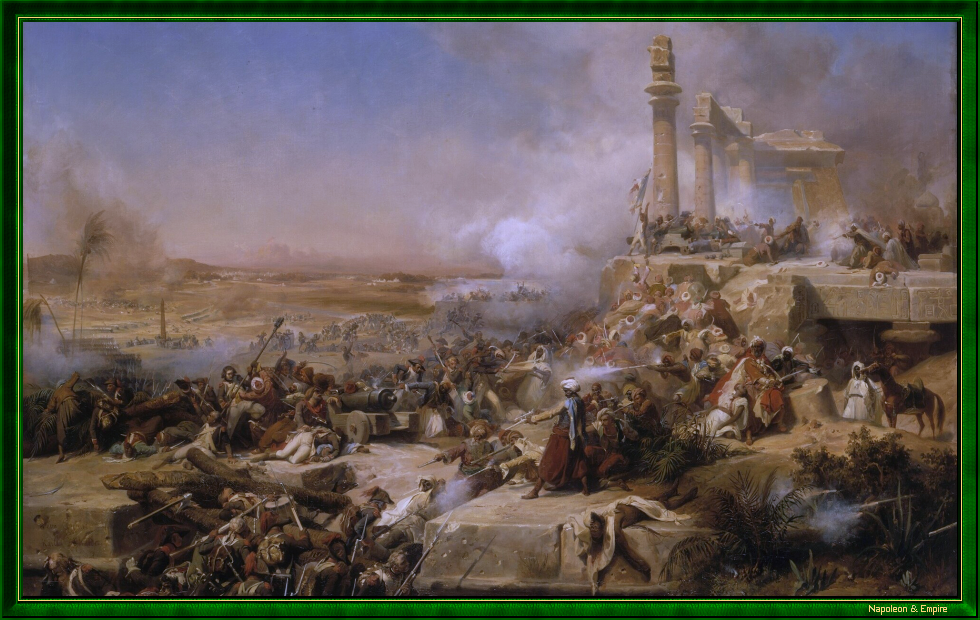Date and place
- March 20, 1800 near the ruins of Heliopolis, then some ten miles from Cairo, now in the city itself.
Involved forces
- French army (around 11,000 men) under the command of General Jean-Baptiste Kléber.
- Ottoman army (between 40,000 and 80,000 men, depending on the source) under the command of Nassif Pasha and Grand Vizier Yusuf Ziya Pasha (Kör Yusuf Ziyaüddin Paşa).
Casualties and losses
- French army: 600 to 800 men killed or wounded.
- Turkish army: 8,000 to 9,000 men dead, wounded or prisoners.
The victory at Heliopolis was General Kléber's response to the English demands for the surrender of the French expeditionary force in Egypt. It was the Ottoman army that paid the price for British rigidity. At the end of the operations that followed the battle, Egypt would be more firmly than ever in French hands.
The general situation
Following Napoleon Bonaparte's departure from Egypt on August 22, 1799, General Jean-Baptiste Kléber, who had been given command of the French expeditionary corps, entered into talks with the Ottomans and their British allies. The talks culminated on January 24, 1800 with the signing of the Convention of El-Arich, which provided for the repatriation of the French to France.
But British Admiral George Keith Elphinstone rendered the agreement null and void by refusing to ratify the commitments made by his subordinate, Commodore Sidney Smith , and demanding outright surrender. The commander-in-chief of the English fleet was convinced that the French army in the East was in no condition to resist its enemies.
Kléber rejected this proposal and prepared to fight.
Hostilities resumed. Nassif Pasha (ﻥﺎﺼﻴﻓ ﺏﺎﺷﺍ) and the Grand Vizier Kör Yusuf Ziyaüddin Pasha (ﻱﻮﺴﻓ ﺾﻳﺍﺀ ﺎﻟﺪﻴﻧ ﺏﺎﺷﺍ ﺍﻸﻌﻣﻯ) , leaders of the Ottoman armies, set off for Cairo [ﺎﻠﻗﺎﻫﺭﺓ], where the population took up arms at their instigation. Murad Bey (ﻡﺭﺍﺩ ﺐﻛ) and Ibrahim Bey (ﺈﺑﺭﺎﻬﻴﻣ ﺐﻛ) , the two main beys of the Mamluks, supported them.
The disposition of the armies
On the eve of the battle, Nassif Pasha occupied the village of El Matareya [ﺎﻠﻤﻃﺮﻳﺓ] [30.12463, 31.31508] with his vanguard of 6,000 elite Janissaries, reinforced with 16 cannons and some cavalry. Grand Vizier Youssouf positioned himself further north between the villages of Abu-Zaabal [ﺄﺑﻭ ﺰﻌﺒﻟ] [30.24122, 31.35236] and El-Kanqah [ﺎﻠﺧﺎﻨﻛﺓ] [30.22014, 31.36867] with the rest of his almost 80,000 men.
Kléber, for his part, had little more than 10,000 at his disposal. During the night of March 19-20, 1800, he led them across the Nile [ﻦﻫﺭ ﺎﻠﻨﻴﻟ] and set them up on the river's right bank, each of the four brigades of his small army forming its own square:
- on the right, the division of Louis Friant with the brigades of Augustin Daniel Belliard and François-Xavier Donzelot ;
- on the left, the division of Jean-Louis Ebénézer Reynier with the brigades of Joseph Lagrange and Antoine Joseph Robin .
The light cavalry of Pierre Leclerc d'Ostein stood between the squares in the center of the array. The reserve artillery was placed to the rear of the left and covered by sappers and grenadiers, as were the few pieces scattered between the squares and on their flanks. The latter were also protected by skirmishers, and the corners by grenadiers.
The battle
At around 3 a.m., the Friant division sprang into action. It bypassed the Ottoman position to the east and positioned itself to cut off the enemy's retreat. The French left wing, led by Reynier, then attacked the village of El Matarieh head-on and captured it, causing the defenders who had survived his ferocious assault to flee.
With their retreat cut off, the Janissaries had to seek refuge in Cairo. A corps of Mamelukes followed suit, sailing past the French to reach the city. A charge by the Compagnie des Guides, soon reinforced by dragoons and chasseurs, failed to completely block their path.
Having gained these first advantages over the Ottoman vanguard, the French squares reorganized and set off towards the villages of Saryaqos [ﺱﺮﻳﺎﻗﻮﺳ] [30.19748, 31.32251] and El-Marg [ﺎﻠﻣﺮﺟ] [30.15199, 31.33564], west of Birkat al-Hajj [Pond of the Pilgrimage - ﺏﺮﻜﻫ ﺎﻠﺣﺎﺟ], now dry and built-up].
On the way, they were attacked by the bulk of the enemy forces, who rushed the Friant division near El-Merg wood. But, as in the battle of the Pyramids, the squares remained impervious to the flow of Turkish cavalry, and the combined fire of French infantry and artillery soon riddled and dispersed the attackers.
Victory was complete. The Turks suffered ten to fifteen times more casualties than the French (600 killed or wounded on one side, 8 or 9,000, including prisoners, on the other), and left a considerable amount of booty behind.
The aftermath of the battle
After sending the Lagrange brigade towards Cairo, Kléber set off in pursuit of the Grand Vizier, who first marched northeast towards Syria via Bilbeis [ﺐﻠﺒﻴﺳ] [30.42015, 31.56203] and El Salheya [ﺎﻠﺻﺎﻠﺤﻳﺓ ﺎﻠﻗﺪﻴﻣﺓ] [30.74554, 32.00433], before packing up what remained of his army and leaving Egypt, ignoring the advice of his English advisors.
Mourad Bey, for his part, whose Mamelukes had remained camped in the desert without taking part in the fighting, signed an agreement with the French a few days later, on April 5, 1800, making him a sort of viceroy of Upper Egypt.
This victory considerably strengthened the position of the French army. All that remained was to retake Cairo, where Nassif Pasha and Ibrahim Bey had managed to enter, forcing the weak French garrison of 200 men to entrench themselves in the citadel. They held out victoriously until April 21, when Kléber recaptured the city. Egypt was more solidly held than ever.
Picture - "The Battle of Heliopolis", engraving by Edme Bovinet (1767-1832), watercolor by Louis François Couché (1782-1849)

Photos Credits
Photos by Lionel A. Bouchon.Photos by Marie-Albe Grau.
Photos by Floriane Grau.
Photos by Michèle Grau-Ghelardi.
Photos by Didier Grau.
Photos made by people outside the Napoleon & Empire association.